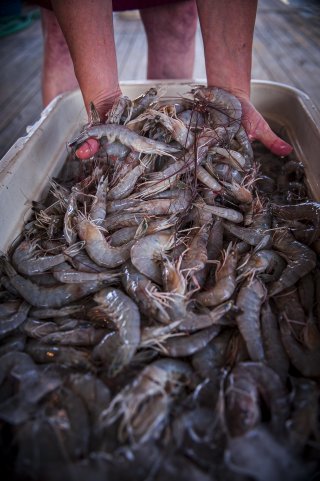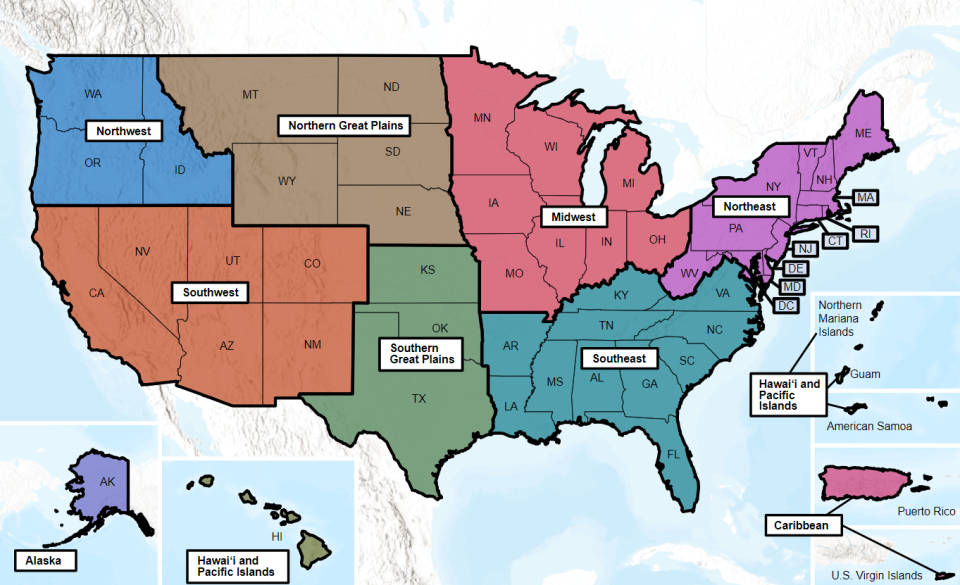Climate Change Connections: Mississippi (Fishing and Shellfisheries)
Climate change is impacting all regions and sectors of the United States. The State and Regional Climate Change Connections resource highlights climate change connections to culturally, ecologically, or economically important features of each state and territory. The content on this page provides an illustrative example. As climate change will affect each state and territory in diverse ways, this resource only describes a small portion of these risks. For more comprehensive information about regional climate impacts, please visit the Fifth National Climate Assessment and Climate Change Impacts by Sector.
On this page:
Introduction: Fishing Is Important for Mississippi’s Culture and Economy

Fishing is a regular past time for many Mississippians. Fish and shellfish are an important part of Mississippi history, traditions, and the culinary scene. Traditional gatherings across the state often bring people together to enjoy fried fish, grilled oysters, or Gulf shrimp. Beyond recreation and tradition, fish play an important role in Mississippi’s economy. No state produces more farmed fish than Mississippi, specifically catfish, which is the largest and most economically valuable sector of the aquaculture industry in the state and in the United States overall.1 Additionally, brown and white shrimp, oysters, and crawfish are raised on Mississippi farms, fished or grown off personal docks, and caught in the wild.2 The aquaculture industry provides jobs in farms, processing plants, feed mills, restaurants, and other types of businesses.
Climate Impacts: Warmer Water Temperatures Threaten Aquatic Health and Fish Farm Productivity

Concentrations of heat-trapping greenhouse gases are increasing in the atmosphere and in response, average temperatures at the Earth’s surface are increasing. Compared to other states, Mississippi has experienced a slower rate of warming, but the state is projected to see further warming in the coming decades.3 Warming air temperatures cause water temperatures to rise, too. Freshwater and marine fish and shellfish species farmed in Mississippi can tolerate a range of warm water temperatures, but there is a limit to the temperatures they can withstand.4
With some variability, shrimp, crawfish, and catfish generally thrive in water temperatures between 60°F and 85°F, but temperatures above that may be harmful.4,5 Warmer water cannot hold as much dissolved oxygen, which all fish and shellfish need to survive. Too-high temperatures can affect fish growth, development, and fertility, and can limit their ability to withstand other water quality changes and diseases or kill them outright.6,7 This can reduce the profitability of farming operations.8
Warmer waters also provide favorable conditions for harmful algal blooms (HABs). Harmful algal blooms occur naturally; however, their growth and preferred habitat conditions are driven by increased and sustained high temperatures. Nutrient runoff resulting from heavy precipitation and flooding also feeds the harmful algal blooms.9 Different species of harmful algal bloom can produce toxins that can harm human health, seabirds, and marine and freshwater life. The toxins can disrupt mariculture and aquaculture, as well as recreational fishing and shellfish harvesting, because of fish kills and toxins staying at levels that are not safe for humans to eat.10 In fresh water bodies, harmful algal blooms can produce toxins or grow so excessively that they block out light, leading to low levels of oxygen in the water; they can also kill fish or clog fish gills. Harmful algal blooms in fresh water that produce toxins also can contaminate drinking water sources.9 In the summer of 2019, the Mississippi Sound experienced a major harmful algal bloom event that resulted in several advisories and months-long beach closures.11
Taking Action: Preparing for Changing Water Conditions
Addressing climate change requires reducing greenhouse gas emissions while preparing for and protecting against current and future climate impacts. Communities, public officials, and individuals in every part of the United States can continue to explore and implement climate adaptation and mitigation measures. In Mississippi, there are opportunities for the mariculture and aquaculture industries to prepare for a changing climate, including:
- Aquacultural adaptation. Species grown in aquaculture ponds or fields cannot migrate to escape warmer water temperatures, so farmers may take steps to mitigate the impacts of warmer waters on their stock.4,5,8 Depending on the species’ life cycle, farmers may work to shift production to a cooler point in the year.8 For other farmed species, adaptations might include altering fish diets, increasing feeding to combat weight loss, or allowing more time for growth.
- Responding to harmful algal blooms. Responding to harmful algal blooms and protecting the health of humans, marine and aquatic life, and valuable seafood stocks starts with awareness—of harmful algal blooms generally, of potential effects, and of how to find information on them, including forecasts and descriptions of present conditions. The EPA, National Oceanic and Atmospheric Administration (NOAA), National Aeronautics and Space Administration (NASA), and the U.S. Geological Survey (USGS) maintain monitoring and surveillance activities in fresh water and salt water across the country. Additionally, the Centers for Disease Control and Prevention (CDC) tracks illnesses, provides support to communities in the event of outbreaks, and offers safety tips. People should avoid contact with water contaminated by harmful algal blooms and avoid ingesting contaminated fish.
To learn more about climate change impacts in Mississippi and the Southeast region, see Chapter 22 of the Fifth National Climate Assessment.
Related Resources
- Harmful Algal Blooms in Water Bodies (EPA)
- Harmful Algal BloomS Observing System (NOAA)
- Mississippi State Climate Summary 2022 (NOAA)
- An Interagency Approach to Harmful Algal Bloom and Hypoxia Research and Control (NOAA)
References
1 U.S. Department of Agriculture National Agricultural Statistics Service. (2019). 2018 Census of Aquaculture (Volume 3, Special Studies, Part 2 AC-17-SS-2). https://www.nass.usda.gov/Publications/AgCensus/2017/Online_Resources/Aquaculture/Aqua.pdf
2 Mississippi State University Extension Service. (n.d.). Other aquaculture species. Retrieved February 23, 2024, from https://extension.msstate.edu/agriculture/catfish/other-aquaculture-species
3 Runkle, J., Kunkel, K. E., Champion, S. M., Frankson, R., Stewart, B. C., & Nielsen-Gammon, J. (2022). Mississippi state climate summary 2022 (NESDIS 150-MS). NOAA National Environmental Satellite, Data, and Information Service. https://statesummaries.ncics.org/chapter/ms/
4 Arnold, M. B., Torrans, E. L., & Allen, P. J. (2012). Influences of cyclic, high temperatures on juvenile channel catfish growth and feeding. North American Journal of Aquaculture, 75(1), 77–84. https://doi.org/10.1080/15222055.2012.732674
5 Zein-Eldin, Z. P., & Griffith, G. W. (1966). The effect of temperature upon the growth of laboratory-held postlarval Penaeus aztecus. 131(1). https://doi.org/10.2307/1539658
6 Mugwanya, M., Dawood, M. A. O., Kimera, F., & Sewilam, H. (2022). Anthropogenic temperature fluctuations and their effect on aquaculture: A comprehensive review. Aquaculture and Fisheries, 7(3), 223–243. https://doi.org/10.1016/j.aaf.2021.12.005
7 O’Gorman, E. J., Ólafsson, Ó. P., Demars, B. O. L., Friberg, N., Guðbergsson, G., Hannesdóttir, E. R., Jackson, M. C., Johansson, L. S., McLaughlin, Ó. B., Ólafsson, J. S., Woodward, G., & Gíslason, G. M. (2016). Temperature effects on fish production across a natural thermal gradient. Global Change Biology, 22(9), 3206–3220. https://doi.org/10.1111/gcb.13233
8 Peterman, M. A., & Posadas, B. C. (2019). Direct economic impact of fish diseases on the east Mississippi catfish industry. North American Journal of Aquaculture, 81(3), 222–229. https://doi.org/10.1002/naaq.10090
9 EPA. (n.d.). Harmful algal blooms (HABs) in water bodies. Retrieved May 14, 2024, from https://www.epa.gov/habs
10 Nwabueze, A. A. (2011). Health implications of harmful algal blooms in tank culture of catfish. Agriculture and Biology Journal of North America, 2(1), 56–60. https://doi.org/10.5251/abjna.2011.2.1.56.60
11 Soto Ramos, I. M., Crooke, B., Seegers, B., Cetinić, I., Cambazoglu, M. K., & Armstrong, B. (2023). Spatial and temporal characterization of cyanobacteria blooms in the Mississippi Sound and their relationship to the Bonnet Carré Spillway openings. Harmful Algae, 127, 102472. https://doi.org/10.1016/j.hal.2023.102472

